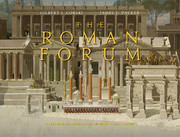Book contents
- Frontmatter
- Map
- Contents
- Preface
- Acknowledgments
- Part I. Architecture in the Roman Forum during the Empire: A Brief History
- Part II. The Monuments
- 3 The Temple of Antoninus and Faustina
- 4 The Temple of Caesar (Aedes divi Iuli)
- 5 The Basilica Æmilia
- 6 The Curia
- 7 The Arch of Septimius Severus
- 8 Minor Monuments
- 9 The Temple of Concord
- 10 The Temple of Vespasian
- 11 The Tabularium
- 12 The Portico of the Dei Consentes
- 13 The Temple of Saturn
- 14 The Basilica Julia
- 15 The Arch of Tiberius
- 16 The Schola Xanthi
- 17 The Diocletianic Honorary Columns
- 18 The Temple of Castor and Pollux
- 19 The Parthian Arch of Augustus (19 BCE)
- 20 The Temple of Vesta
- Part III. Conclusions
- Glossary
- Notes
- Bibliography
- Sources for Coin Images from the Internet and for Other Images
- Index
18 - The Temple of Castor and Pollux
from Part II. - The Monuments
Published online by Cambridge University Press: 05 March 2015
- Frontmatter
- Map
- Contents
- Preface
- Acknowledgments
- Part I. Architecture in the Roman Forum during the Empire: A Brief History
- Part II. The Monuments
- 3 The Temple of Antoninus and Faustina
- 4 The Temple of Caesar (Aedes divi Iuli)
- 5 The Basilica Æmilia
- 6 The Curia
- 7 The Arch of Septimius Severus
- 8 Minor Monuments
- 9 The Temple of Concord
- 10 The Temple of Vespasian
- 11 The Tabularium
- 12 The Portico of the Dei Consentes
- 13 The Temple of Saturn
- 14 The Basilica Julia
- 15 The Arch of Tiberius
- 16 The Schola Xanthi
- 17 The Diocletianic Honorary Columns
- 18 The Temple of Castor and Pollux
- 19 The Parthian Arch of Augustus (19 BCE)
- 20 The Temple of Vesta
- Part III. Conclusions
- Glossary
- Notes
- Bibliography
- Sources for Coin Images from the Internet and for Other Images
- Index
Summary
The Early Republic
Located close to the Shrine of Vesta (Figs. 0.1, 18.2, 20.1), the Temple of Castor and Pollux (famous and important deities throughout Roman history) was the largest sacred structure in the Forum and, in all periods, one of its most important centers. It dated from the early fifth century BCE, and tradition connected it with a famous Roman victory over Rome’s neighbors, the Latins, near Lake Regillus, fourteen miles from Rome, just north of Frascati. In this crucial battle for Rome’s safety, the Latins had sided with the ousted king of Rome, who had been expelled some years earlier. In the prosaic account by the Roman historian Livy, the battle was long and hard. Finally, hoping for divine help, the Roman commander, Aulus Postumius, vowed a temple to Castor and Pollux and promised rewards to the first and second soldiers to enter the Latin camp. Thus encouraged, his forces bested the Latins. But, for the more credulous, there was a famous legend about the battle and its aftermath.
As the Roman cavalry (the equites) charged the Latins, two extraordinarily handsome young men on horses appeared. Leading the charge, they drove the helpless Latins before them. When the Romans had captured the Latin camp, the two appeared again at the Spring of Juturna near the Temple of Vesta in the Roman Forum. By the disorder of their clothes and the sweat on their steeds, they appeared to have been fighting, and, after they had watered their steeds, the Romans gathered around to ask news of the battle with the Latins. The youths described the fight and reported the Roman victory. Then, vanishing from the Forum, they were never seen again. The next day, when a letter from Postumius arrived with news of the Roman victory, the Romans realized the two handsome strangers were the gods Castor and Pollux, the children of Zeus and Leda, and accepted Postumius’ vow for a temple in their honor. Postumius died before completing the temple, but, some years later, his son dedicated it on July 15, 484/483, the anniversary of the famous battle.
- Type
- Chapter
- Information
- The Roman ForumA Reconstruction and Architectural Guide, pp. 284 - 300Publisher: Cambridge University PressPrint publication year: 2015



